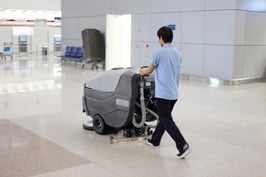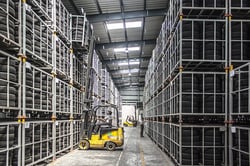 Current US laws impose ‘no limit on how many hours US workers can work’ and those who undertake more than 40 hours a week qualify for overtime pay at 1.5 times their normal wage; so it is unsurprising to find that an estimated 80 percent of Americans continue to work after their mandated working day has ended. However, not having a work-life balance can have a long-term effect on staff productivity.
Current US laws impose ‘no limit on how many hours US workers can work’ and those who undertake more than 40 hours a week qualify for overtime pay at 1.5 times their normal wage; so it is unsurprising to find that an estimated 80 percent of Americans continue to work after their mandated working day has ended. However, not having a work-life balance can have a long-term effect on staff productivity.
With developments in robotic technology advancing at a high rate, such as Boston Dynamics’ backflipping humanoid robot, can robots really step in to cover the overtime currently worked by humans? In more industries than you may imagine...
Cleaning industry
 In the medical sector, cleanliness is critical to prevent infections or viruses from spreading, so the task must be completed before the worker can clock off. According to Cleaning & Maintenance Magazine, ‘Where previously one member of the overnight team was tied up cleaning floors using a conventional scrubber drier, that person can now concentrate on other tasks or respond to cleaning requests in nearby areas while the robot (named Zig) gets on with cleaning the floors.’
In the medical sector, cleanliness is critical to prevent infections or viruses from spreading, so the task must be completed before the worker can clock off. According to Cleaning & Maintenance Magazine, ‘Where previously one member of the overnight team was tied up cleaning floors using a conventional scrubber drier, that person can now concentrate on other tasks or respond to cleaning requests in nearby areas while the robot (named Zig) gets on with cleaning the floors.’
For floor cleaning machines to have the manoeuvrability required to navigate through wards with minimal need for human intervention, battery power is indispensable. Ultralife Corporation have many years of experience in providing batteries for the medical industry and can produce solutions that are certified to medical legislation, giving assurance of reliability. A dependable battery is vital as it can also be used to provide back-up power to retain the robot’s memory - to help it learn which spaces it has cleaned, improving efficiency.
Office work
 The amount of information that robots will have to store is set to increase as they take on clerical job roles as well as operative ones. The Guardian reports that they ‘are expected to replace mortgage brokers, paralegals, and accountants […] one Canadian company […] has automated management processes to such an extent that it no longer has a human resources department.’
The amount of information that robots will have to store is set to increase as they take on clerical job roles as well as operative ones. The Guardian reports that they ‘are expected to replace mortgage brokers, paralegals, and accountants […] one Canadian company […] has automated management processes to such an extent that it no longer has a human resources department.’
In the finance industry, best practise must be followed to ensure compliance with relevant laws e.g. Financial Conduct Authority. Once the robot has acquired it's knowledge it would be costly to re-train it following a power outage. As preventing power failure is key, consideration should be given to the service life of the robot battery. Ultralife’s range of Lithium Iron Phosphate (LiFePO4) batteries are well-suited as an uninterruptable power supply in stationary robots as they offer an outstanding service life of 5 to 7 years, compared with around 2 years for typical Lead Acid batteries. If these batteries are housed inside the machine, this extended service life means that machines won't need to be replaced as often, saving time and money.
Catering industry
Just as machines undertaking clerical work must be law abiding, those in the catering industry must follow health and safety laws to ensure that food is cooked thoroughly and hygienically. This is not only applicable to catering robots in industrial environments but also the home; an emerging market.
 ‘London-based company Moley Robotics expects to start selling its automated kitchen technology this year, promising it can download a recipe and "reproduce it exactly as the MasterChef would have cooked it’ (Australian Broadcasting Corporation). As kitchens can change from being extremely hot, depending on whether the oven is in use, to cold environments; temperature is also a consideration in the selection of a battery.
‘London-based company Moley Robotics expects to start selling its automated kitchen technology this year, promising it can download a recipe and "reproduce it exactly as the MasterChef would have cooked it’ (Australian Broadcasting Corporation). As kitchens can change from being extremely hot, depending on whether the oven is in use, to cold environments; temperature is also a consideration in the selection of a battery.
Ultralife’s UBI-2590 range offer impressive cold temperature discharge performance and, whilst discharging, can operate in a temperature range of -32°C to 60°C.
Logistics industry
 Moving away from the kitchen and into the warehouse, another industry that is affected by health and safety legislation is logistics where many repetitive tasks can cause strain injuries in human personnel. One factor that has slowed the uptake of robotics in piece picking is, according to Supply Chain Management Review, ‘the ability for the robot to “see what a person can see when the robot doesn’t know what’s coming.”’
Moving away from the kitchen and into the warehouse, another industry that is affected by health and safety legislation is logistics where many repetitive tasks can cause strain injuries in human personnel. One factor that has slowed the uptake of robotics in piece picking is, according to Supply Chain Management Review, ‘the ability for the robot to “see what a person can see when the robot doesn’t know what’s coming.”’
Improvements in sensor technology are advancing autonomous capabilities in this area. Battery technology is also allowing piece picking co-bots to work alongside humans.
Media industry
 As well as working with humans, robots are also starting to replace humans, perhaps even presenting the news in the near future. ‘Erica, a lifelike android designed to look like a 23-year-old woman, may soon become a TV news anchor in Japan’, Live Science reports. Of course, automation in front of the camera would need to be aesthetically pleasing, so no visible hanging wires and as human-like as possible.
As well as working with humans, robots are also starting to replace humans, perhaps even presenting the news in the near future. ‘Erica, a lifelike android designed to look like a 23-year-old woman, may soon become a TV news anchor in Japan’, Live Science reports. Of course, automation in front of the camera would need to be aesthetically pleasing, so no visible hanging wires and as human-like as possible.
Custom designed batteries can be made to fit the specific space requirements of the device and have case colour customised to match the robot’s appearance; making it virtually impossible to notice.
Essential in allowing robotics to fulfil more varied functions is portable power, which can aid with manoeuvrability and the retention of critical data. Ultralife Corporation offer a range of pre-engineered and custom solutions to meet the needs of OEMs in the robotics sector.
Have an idea about what power to use in your robot but wish to see how it aligns with other organisations? Why not take part in our research and we will send you an anonymised copy of the results?



